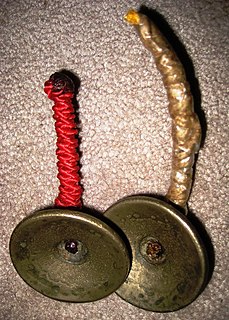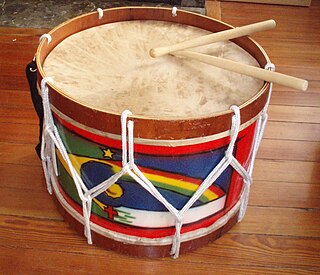
The snare is a percussion instrument that produces a sharp staccato sound when the head is struck with a drum stick, due to the use of a series of stiff wires held under tension against the lower skin. Snare drums are often used in orchestras, concert bands, marching bands, parades, drumlines, drum corps, and more. It is one of the central pieces in a drum set, a collection of percussion instruments designed to be played by a seated drummer and used in many genres of music.

Timpani or kettledrums are musical instruments in the percussion family. A type of drum categorised as a hemispherical drum, they consist of a membrane called a head stretched over a large bowl traditionally made of copper. Thus timpani are an example of kettle drums, also known as vessel drums and semispherical drums, whose body is similar to a section of a sphere whose cut conforms the head. Most modern timpani are pedal timpani and can be tuned quickly and accurately to specific pitches by skilled players through the use of a movable foot-pedal. They are played by striking the head with a specialized drum stick called a timpani stick or timpani mallet. Timpani evolved from military drums to become a staple of the classical orchestra by the last third of the 18th century. Today, they are used in many types of ensembles, including concert bands, marching bands, orchestras, and even in some rock bands.

Dhol can refer to any one of a number of similar types of double-headed drum widely used, with regional variations, throughout the Indian subcontinent. Its range of distribution in India, Bangladesh and Pakistan primarily includes northern areas such as the Punjab, Haryana, Delhi, Kashmir, Sindh, Assam Valley, Uttarakhand, West Bengal, Odisha, Gujarat, Maharashtra, Konkan, Goa, Karnataka, Rajasthan, Bihar, Jharkhand and Uttar Pradesh. The range stretches westward as far as eastern Afghanistan. A related instrument is the dholak or dholki.

Yakshagaana is a traditional theatre, developed in Dakshina Kannada, Udupi, Uttara Kannada, Shimoga and western parts of Chikmagalur districts, in the state of Karnataka and in Kasaragod district in Kerala that combines dance, music, dialogue, costume, make-up, and stage techniques with a unique style and form. It is believed to have evolved from pre-classical music and theatre during the period of the Bhakti movement. It is sometimes simply called "Aata" or āṭa. This theatre style is mainly found in coastal regions of Karnataka in various forms. Towards the south from Dakshina Kannada to Kasaragod of Tulu Nadu region, the form of Yakshagana is called Thenku thittu and towards the north from Udupi up to Uttara Kannada it is called Badaga thittu. Both of these forms are equally played all over the region. Yakshagana is traditionally presented from dusk to dawn. Its stories are drawn from Ramayana, Mahabharata, Bhagavata and other epics from both Hindu and Jain and other ancient Indic traditions.

The davul, dhol, tapan, atabal or tabl is a large double-headed drum that is played with mallets. It has many names depending on the country and region. These drums are commonly used in the music of the Middle East and the Balkans. These drums have both a deep bass sound and a thin treble sound due to their construction and playing style, where different heads and sticks are used to produce different sounds on the same drum.
Batucada is a substyle of samba and refers to a percussive style, usually performed by an ensemble, known as a bateria. Batucada is characterized by its repetitive style and fast pace. As is Samba, the Batucada is a Brazilian musical expression with African roots.

A repinique is a two-headed German drum used in samba baterias. It is used in the Rio de Janeiro and São Paulo Carnival baterias and in the baterias of Bahia, where it is known as repique. It is equivalent to the tik-tik in the non-Brazilian drum kit or to the tenor drum in marching bands. It is tuned very high to produce a tone that cuts through the sound of the rest of the bateria and it is a lead and solo instrument.

The Chanda is a cylindrical percussion instrument originating in the state of Kerala and widely used in Tulu Nadu of Karnataka and Tamil Nadu in India. In Tulu Nadu, it is known as chende. It is greatly identified as a cultural element in Kerala and Tulu Nadu.
Tala-Maddale is an ancient form of performance dialogue or debate performance in Southern India in the Karavali and Malnad regions of Karnataka and Kerala. The plot and content of the conversation is drawn from popular mythology but the performance mainly consists of an impromptu debate between characters involving sarcasm, puns, philosophy positions and humour. The main plot is sung from the same oral texts used for the Yakshgana form of dance- drama. Performers claim that this was a more intellectual rendition of the dance during the monsoon season.

Karnataka has a variety of traditional arts, including folk dance and puppetry.
Sri Idagunji Mahaganapati Yakshagana Mandali, Keremane (R)(Kannada: ಇಡಗುಂಜಿ ಮಹಾಗಣಪತಿ ಯಕ್ಷಗಾನ ಮಂಡಳಿ)or simply the Keremane Yakshagana Troupe is a Yakshagana troupe based in the Uttara Kannada district of Karnataka, India. It was started by Keremane Shivarama Hegde in 1934. He is an exponent of this art form and is the first Yakshagana artist to win the Rashtrapati Award, an award handed out by the President of India to people who excel in various fields. The troupe has survived three generations, with his children Shambu Hegde, Mahabala Hegde and Gajanana Hegde and his grand son Shivananda Hegde also being exponents of Yakshagana. Keremane Shivananda Hegde is the current director of the troupe and the institution.
Yakshagana Tala, is a rhythmical pattern in Yakshagana that is determined by a composition called Yakshagana Padya. Tala also decides how a composition is enacted by dancers. It is similar to Tala in other forms of Indian music, but is structurally different from them. Each composition is set to one or more talas, and as a composition is rendered by Himmela, the percussion artist(s) play supporting the dance performance. Tala is maintained by the singer using a pair of finger bells.

The Maddale also called Mrudanga(ಮೃದಂಗ) in North Canara region is a percussion instrument from Karnataka, India. It is the primary rhythmic accompaniment in a Yakshagana ensemble along with Chande. Maddale also represents a remarkable progress in percussive instruments as it produces the perfectly hormonic tonic when played anywhere on the surface compared to Mrudangam, Pakawaj or Tabla that can not produce the tonic (shruti) on all parts of the drum surface. The traditional variety of Maddale was 30 cm long, had 8 inch drum head for right and produced the louder sound. These days 6 - 6.5 inch wide right side maddale is used with only a few using 7 inch wide. Left bass side is about an inch bigger than right. Maddale is available in more than three different variations. Maddale used in Yakshagana looks similar to mridangam but is markedly different in structure, acoustics, playing techniques and the rhythm system.

The Yakshagana bells or Yakshagana cymbal are a pair of finger bells made of a special alloy used in Yakshagana(Badagu Thittu). They are used by the singer to keep the tempo and rhythm of Yakshagana performance. The pitch of the bells are very high and do not match the tonic of the singer. Due to their high pitch usually singers use bells of any key. Professional singers maintain and treasure their personal finger bells.

The parai is a traditional Tamil frame drum about 35 centimeters in diameter, used in the parai attam dance. It consists of a shallow ring of wood, covered on one side with a stretched cow hide that is glued to the wooden frame. The preferred wood is neem wood, although other types may be used. The shell is made up of three pieces of wood each in the shape of an arc, held together by three metal plates. The parai is played with two sticks

The alfaia is a Brazilian membranophone. It is a wooden drum made of animal skin tensioned or loosened through ropes placed alongside the body of the instrument.
The Loh Tarang is a melodic percussion instrument. It consists of a set of iron circular plates, of different sizes, held in a frame. Each plate is pitched to a note and they are struck with sticks on each hand. 'Tarang' literally means waves. Plates sound depends on the different size of plate and hand movement. Theory is based like Jal-Tarang.

Veekku Chenda or "Acchan Chenda" is a type of Chenda or drum used to keep the "thalam" or the basic rhythm while playing the Chenda. The "Chenda Vattam" of the "Veekku Chenda" is always the "Valam Thala" or the "Right Head" which is made of multiple layer of skin to produce a bass sound. The meaning of "Veekku" in Malayalam language is "beating hard". The artist produce sound on "Veekku Chenda" by hitting the drum using a stick without twisting or rolling his wrist.

Uruttu Chenda is a type of "Chenda" or drum used to play variations in Chenda music. It is used to lead the orchestra. It is called the ""Pramanavadhya"". The "Chenda Vattam" of the "Uruttu Chenda" is always the "Edam Thala" or the "Left Head" which is made of soft, single cow skin. The meaning of "uruttu" in Malayalam language is "rolling". The artist produce sound on "Uruttu Chenda" by rolling his right hand wrist. During the first beat the palm holding the stick will face the artist (in), then during the second beat the palm would face the opposite side (out). This is done by rolling the wrist.













